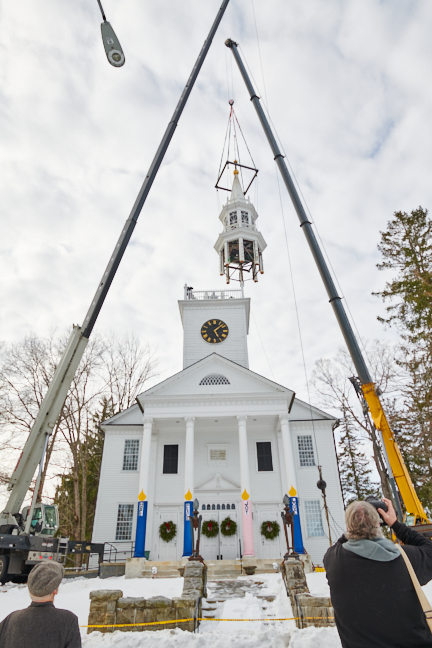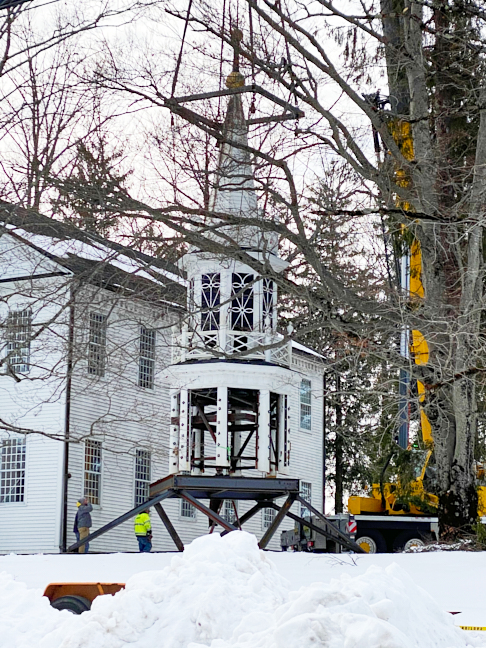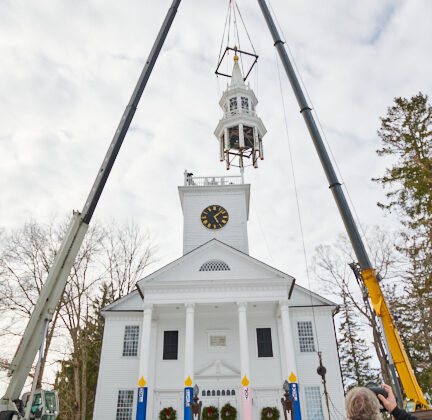How to Remove the Congregational Church’s Steeple — Very Carefully
Repairs to the clock tower and belfry can begin
Text by Ruth Melville
After years of planning, consultation and crossed fingers, the steeple on the top of Norfolk’s Church of Christ Congregational was successfully removed last December, enabling the much-needed repair of the tower and steeple.

In 2015, during routine work on the clock tower, it was discovered that the wooden beams in the tower and the eight wooden columns supporting the belfry were rotting in places. The problem became more urgent in 2019, when Matt Szydlo, an engineer from Harwinton, examined the tower and reported it to be unsafe at winds over 40 miles per hour.
After consultations with engineers about the various options, the church decided to cut off the steeple above the clock tower and place it on the ground, where it could be repaired. Meanwhile, the rotten support beams inside the tower would be replaced.

According to David Torrey, chair of the church’s Gifts and Finance Committee, two things in particular had to happen before the steeple could be safely removed.
The first was to build a steel cage inside the wooden columns to stabilize the belfry. This work was overseen by the church sexton, Gimo Ramadani, with help from Jesse Bourgoin. Jesse’s father, Jim, who’s been a welder for 40 years, came in to do a lot of the welding. The cage was installed shortly after the August hurricane Isaias passed through the Northeast, bringing winds that were much higher than 40 miles per hour. Once the cage work was completed, Torrey says, “I wasn’t concerned about it falling anymore.”
Ramadani and Bourgoin also had to drill holes, 32 of them in all (four at each of the eight columns), so that the cables that that would raise the steeple could be threaded through the roof of the belfry.
The second requirement was to make a secure base on the ground to support the steeple once it was removed. A gravel pit was dug into which four concrete piers were sunk.
Millard Welding in Colebrook manufactured the steel cradle in which the steeple would be placed. Torrey says that everything had to be absolutely level, and the steeple had to fit into the cradle precisely. The manufacturing process ran into delays, and in the end the cradle was not fully installed until two days before the scheduled lifting of the steeple on Dec. 23.
Luckily, the weather that day was clear and calm, although the cradle had to be cleared of several inches of fresh snow. Early in the morning, A-Quick Pick Crane and Rigging Service, from Derby, moved two giant cranes into position on either side of the church, one to carry up the riggers, the other to lift the steeple. Torrey is grateful to the Battelle-Stoeckel Estate for their help. “We couldn’t have done it without their giving us permission to use their land.”
Most of the rest of the morning was spent securing the steeple to the lift ring. A crane lowered the ring down over the spire, and cables attached to the ring were threaded through the holes drilled at the eight column points. Once the ring was lifted enough to bear the weight, the riggers cut through the steel supports and the wooden columns to free the steeple.
Shortly after 1 p.m., as a small crowd stood watching on the Village Green, the steeple slowly, smoothly and silently rose into the air. The cable swung the structure gently around and lowered it cleanly onto the base, where it was welded in place.

All that remains at the top of the church tower are the sawed-off tops of the columns, now covered with black plastic bags to keep out the rain, and the main church bell, a 2,025-pound Meneely & Kimberly bell, cast in 1876. The five smaller bells can remain in the belfry during the repair.
The next steps are to clean and paint the steeple, replace the wooden columns with steel ones, and repair the lantern tier with its apron roof. The new material will be attached to steel bracing installed in the clock tower in the 1960s. To avoid having to hire a crane again, the old columns will be lowered through the roof. Torrey intends to install a demolition chute from a window at the rear of the tower to get remove all the old rotten beams and posts.
Finally, the church team needs to devise a system not only to put the steeple back without further damage but to enable it to be raised easily the next time repairs need to be done. With luck, that won’t be for many decades to come. The church was built in 1813, over 200 years ago, and Torrey hopes that the new support structure and columns will last a minimum of another 200 years.

